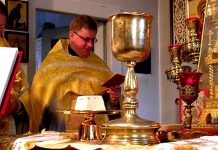Table of contents
About the Prayer of the Heart – The Prayer of Jesus
This year, 2014, I am re-writing everything about the Prayer of the Heart. It is necessary for the following reasons:
- — the discoveries I have made in the last 20 years
- — the discoveries others have made in this time (and which I have found out about)
While it could have been true 20 years ago that the teachers (Elders, Fathers, Gerontas, Startzi) could not be “discovered” or “unearthed”, as I then wrote, to our delight the situation has radically changed. The big question is: “has something changed outside, or have the changes been inside?” The answer is no doubt that changes have taken place in both in an out.
Prayer of the Heart, also known as the Prayer of Jesus in Christianity, can be traced back nearly 2000 years. According to St. Paul what we should do is to: “Pray without ceasing” .
Many of the writings of the “desert fathers” (of whose lives very little can be verified from the records of history) and others who were engaged in the ‘spiritual warfare’, and who practised the prayer, are preserved in the Philokalia.
The Love of Beauty
The Greek Philokalia was compiled by Metropolitan Macarius of Corinth and St. Nicodemus Hagiorite and first published in Venice 1782. There are three basic version of the Philokalia: the original Greek, the Slavonic and the Russian translations (the latter two are of course translations).
The texts of Philokalia cover the writings of the Fathers of the Church from the fourth to the fourteenth century.
The translations to the English are from the Greek and the Russian, but there are also translations to many different languages. Of these the Russian text, translated and edited by St. Theophan the Recluse, is interesting also because St. Theophan edited the earlier Slavonic version to make it more understandable. The Greek Philokalia has five volumes. The Russian edition is called “Dobrotolubiye” and like the Greek original, it means “Love of Beauty”.
Philokalia tells us how to pray!
Prayer of the Heart is also know as the ‘art of arts’ and the ‘royal art’; it is possible to practice it and it can be learned from those who know how to pray. Who are they?
Silence on Juojärvi Lake New Valaam
Photo by: Arvo Ratavaara 2010
However, as an Orthodox Christian I did find myself in quite a strange situation for exactly 50 years (1961 – 2011). The tradition of the Prayer of the Heart is part of the Orthodox tradition. Who is teaching it? I thought that one should find someone among the priests, but, and this is in spite of meeting many spiritually advanced people, I I did not come across any such priest. Where were those people who could teach me how to pray continuously?
From the time I started my ‘search for truth’ there has been a popular tendency in the western world to look for spiritual teachers (and also teachings) from among the many ‘gurus’ from the East; earlier more from the Far East (Buddhism, Yoga, Vedanta), and now also from the Middle East (Sufism and Kabbalah). No doubt this tendency is also fully justified as the spiritual teachers in our time in the West have been few and far between. Moreover, is Christianity not also a teaching from the Middle East?
In our time teachers of all sorts can be found also in the West. For example within the Catholic Church there is a strong ‘movement’ to fetch knowledge and practice from Zen Buddhism, and this seems to continue. It is quite common that instead of a priest, we have a Zen Master whose prior education is Christian theology. Why does a priest not learn what he should learn – like how to pray, and also to teach others in how to pray? This is a confirmation of a sad state of affairs: Christian practice is not taught in the Universities! What are taught are morality, psychology and theory; what are not given and taught are the tools and the ability to be able to apply them into practice.
As the education of the average Christian priests does not include the learning of the ‘art of arts’ (although Orthodoxy is an exception) it is not possible by any even superhuman efforts for a priest to teach others how to pray; both the knowledge and the ability are lacking. This is why those who are in the position of ‘educators’ (priests) in the churches need to go to other religions and find their ‘gurus’ to learn the basics of spiritual practice. In other words they have a need to fetch the ‘know how of spiritual life’ from outside Christianity.
This search for the ‘know how’ is highly necessary.
A case in point: in the 1950’s what was left of the Russian monasteries had such a lack of spiritual teachers (after all Stalin and the Soviet regime killed roughly 100000 monks, nuns and priests) that Father Michael (see column on right), who had managed to survive and settle in the New Valaam in Finland, was asked to move to the Russian territory, which he did with some other monks. What happened to them is not in my knowledge. All I know is that when he arrived in Kiev, he wished to go into seclusion and teach no more. Are there any of the Startzy left in Russia? What happened to the tradition of the Optina monastery with such a long chain of oral teachings by the elders to both monks and the lay people? At the time of writing (2012) Optina is alive again, and most likely there are also new Elders in the monastery. Here is a link to a virutal tour Optina Monastery Virtual Tour
View of the virtual tour of the Optina Monastery as it is today
Much of what is connected with the practice of the Prayer of the Heart is a ‘well kept secret’. This web site is an attempt to find some of these secrets and to help to revive the practice of the Prayer for our time to the extent it is possible in this media (internet).
Click for another Icon
St. George and the Dragon
Athos Foundation in Lammi
In very cold January 2016
Background photo by Reijo Oksanen, 2013 Solovetsky Monastery in Russia
Books by Bishop Kallistos (Ware)
www.prayerofheart.com
Archimandrite Placide Deseille is Higoumen of the Monastery of Saint Anthony the Great, St.-Laurent-en-Royans, France, and professor at the St. Sergius Theological Institute in Paris. The following thoughts are adapted from a talk he gave at a local parish on 6 March 2008, originally published by the Service Orthodoxe de Presse (SOP), supplement no. 327, April 2008.
The expressions “Prayer of the Heart” and “Prayer of Jesus” or “Jesus Prayer” are often used as equivalents. They should, however, be clearly distinguished one from the other. According to a person’s degree of spiritual maturity, the “Jesus Prayer” can be either active or contemplative. In the latter case, it becomes a true “prayer of the heart.”
The Jesus Prayer is composed chiefly of the name of Jesus. Athonite monks pray continuously: “Lord Jesus Christ, have mercy on me!” It can begin with a confession of faith: “Lord Jesus Christ, Son of God.” The cry for “mercy” is then uttered as a call for God to pour out His grace upon us (“mercy” is closely related to the Greek term for “oil,” which in Hebrew usage was a symbol of blessing). The Jesus Prayer is thus a “verbal icon” of Christ, which communicates to us the deifying grace or energy of the Risen Lord.
This invocation becomes true “prayer of the heart” only under certain conditions. The 19th “Spiritual Homily” of St. Macarius of Egypt says this: “When persons draws near to the Lord, they must first do violence to themselves in a strenuous effort to await His grace with unshakeable faith… They must struggle to pray even when they lack ‘spiritual prayer.’ When God sees how just how they persevere in the struggle, even when their heart is not in it, God will grant them the gift of true spiritual prayer, true charity, true tenderness and compassion. In a word, God will fill them with the gifts of the Holy Spirit.” …
This struggle involves us in the active phase of prayer. It is not, however, a “method” that will lead us deeper into the spiritual life. That can only occur when we respond with humility to the grace of God. Repeating the prayer constantly has special value insofar as it leads us beyond discursive reasoning and other forms of mental reflection. It leads to simplicity and openness of heart that focuses the soul uniquely on Christ. Humility is the key to this inner movement. It enables us to sense God’s Presence and help, and to welcome His gift of salvation. It promotes confidence in God, trust that He will see us through times of chaos and tumult, that He will be our Light when we walk through darkness, that He will comfort us in times of illness, spiritual struggle and distress. All of this God offers us through the Prayer of Jesus.
Once this prayer has taken root within us, our heart is illumined by a deep confidence, in which we are spared of the former blindness that allowed us to pray only with the lips. Now we welcome prayer as an ineffable treasure. As spiritual guides have so often declared, “the Prayer of Jesus is a joy that elicits a response of thanksgiving.”
At this point in the spiritual pilgrimage, the heart becomes transformed by grace. Nevertheless, God allows us again and again to be tempted, to teach us that it is in Him alone that we can find our strength and the fulfillment of our hope. This is why it is so necessary that we learn to accept our weakness and frailty with a spirit of genuine humility. No one can acquire humility other than by using the appropriate means, means that lead to a humble and broken heart and the elimination of our presumptuous thoughts. For all too often the Enemy discovers the weak points within us, and that allows him to turn us from the way that leads to Life.
Without humility, it is impossible for a person to attain spiritual “perfection.” We learn by trials, and without them, no one can acquire true humility.
That acquisition necessarily involves a “broken heart” and ardent prayer. Such humility allows those who love us to draw near to us and to manifest that love. However great the trials and temptations, they can always become, by the grace of God, the means by which we attain genuine humility and thus gain the Kingdom of Heaven. Those trials may involve our inner life: assault by corrupting thoughts, or surges of pride (which is so often a manifestation of our shame and woundedness). They may also involve attacks against our body: illness, old age, neglect on our part or the part of other people. Sometimes they come, too, from overt attacks by others: by abuse or abandonment. In any case, such trials are needed, in order to lead us into a state of true humility.
It is in that state of humble acceptance of our trials—constantly remitting them into the loving hands of God—that the Prayer of Jesus can become true Prayer of the Heart.
oca.org
About the Course
Prayer can be one of the most confounding of spiritual practices. If it is a personal, meditative, soul experience, then why is so much of it dictated by formality and structured liturgy? If we are praying to an all-knowing higher power, then why do we need to express thoughts, feelings and needs that are already revealed? It turns out that prayer is about developing a relationship. And just like any intimate relationship, it is full of nuances and subtleties; there is both an art and a science to prayer.
Course Syllabus
| Why We Pray
Part 1 of The Heart of Prayer Does G-d really need our prayers? Obviously not. He wants our prayers. But why? The same question can be asked about existence as a whole – G-d doesn’t need a world, but He wants one, and wishes to have a relationship with every being in it. Through prayer, we explore and express our relationship with the Divine, and with the Divine Soul within us. It is our way of bridging the finite and the infinite aspects of life, and connecting with the purpose of our existence. 85 Comments |
| The History of Jewish Prayer
Part 2 of The Heart of Prayer Though the formal prayers found in prayerbooks today were established in Talmudic times, the origin of prayers dates much earlier, to Biblical times. The three patriarchs, Abraham, Isaac and Jacob, each introduced one of the three daily prayers, and their names are invoked within the prayers. In this lesson we explore that connection between prayer and the patriarchs, as well as several other fascinating insights about prayer and its connection to our physical and emotional makeup. 37 Comments |
| A Tour of The Daily Prayers
Part 3 of The Heart of Prayer At first glance, the structure of the prayers in the prayerbook may seem arbitrary. How did the “Men of the Great Assembly,” the Talmudic Sages who authored the basic liturgy of Jewish prayer, devise the structure that has remained for over 2,000 years? In this lesson we discover that daily prayer is a ladder comprised of four rungs – acknowledgment, emotion, intellect and submission – that we are meant to climb in our daily spiritual practice. 21 Comments |
| Guided Meditation
Part 4 of The Heart of Prayer The core of every prayer service is the “Amida” or “Shmoneh Esreh” – the silent prayer. But in fact it is not so silent. In order to fulfill the requirements of the silent prayer, we have to physically verbalize the words so that we can hear the words we’re saying. In this lesson we will learn why meditative prayer is both silent and not silent, and also explore several meditations, some of them quite mystical, that deepen our connection to the meaning behind the words. 27 Comments |
www.chabad.org















